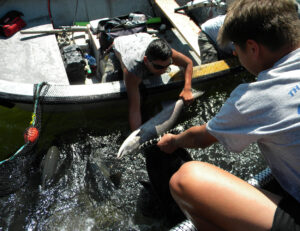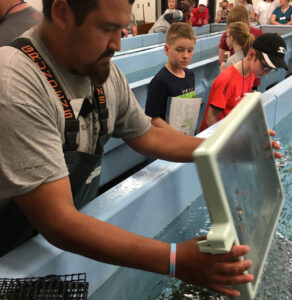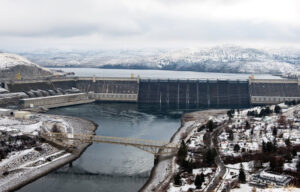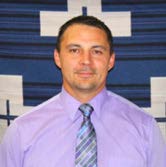The Confederated Tribes of the Colville Reservation depend on hydropower for energy and revenue through their stake in the Grand Coulee Dam and Wells Dam hydropower projects. How do they balance that dependency with the importance of healthy land, water, and wildlife? In this interview, Cody Desautel, director of the tribe’s natural resources division, speaks with Hydro Leader about the tribes’ work with its partners, including local public utility districts, to mitigate the dams’ effects on natural and cultural resources.
Hydro Leader: Please tell us about your background and how you came to be in your current position.
Cody Desautel: I am the natural resources division director for the Colville Tribes. I have a bachelor’s degree in environmental science and a master’s degree in Indian law. Most of my early career was spent in forestry. I’ve been in the natural resources director position since 2014. As the natural resources director, I am responsible for the oversight of all natural resources programs, many of which are affected by the operation of the hydropower projects. The two that are most affected are fisheries and cultural resources. In addition, I am designated to work with Douglas Public Utility Department (Douglas PUD) in the marketing and sale of Colville’s allocation of power from the Wells Dam Project.
Hydro Leader: Please tell us about the Colville Tribes.

Cody Desautel: Colville is a confederacy of 12 tribes that range from northeast Oregon (the Chief Joseph band of Nez Perce) through much of eastern Washington and well into Canada (the Arrow Lakes and Okanogan Tribes). These tribes have a diverse set of cultures and speak languages from three distinct language groups. Those tribes exist today on the 1.4 million acres that remain of the 2.9‑million-acre reservation that was established in
1872. Timber revenue has been a considerable part of tribes’ revenue stream throughout the entirety of their history. Of those 1.4 million acres, about 920,000 are forested. There are two dams on the reservation: Chief Joseph Dam, operated by the U.S. Army Corps of Engineers, and Grand Coulee Dam, operated by the Bureau of Reclamation. The power produced by both is sold by the Bonneville Power Administration (BPA). The Wells Dam Project, operated by the Douglas PUD, is downriver of the reservation, but the Wells Pool that it creates inundated portions of the reservation.
Hydro Leader: Please tell us about the natural resources division’s program and staff.
Cody Desautel: The natural resources division includes 15 programs and has 500–600 staff, depending on seasonal appointments. This includes all of what you would consider natural resources programs, such as forestry, fire, fish and wildlife, history and archeology, and parks and recreation programs and our real estate services branch. We also have an ag component for which we contract the management, so we have a pretty diverse group of programs.
Hydro Leader: Do you have a tribal utility company?
Cody Desautel: Currently, five different utilities service the reservation, with a variety of rates and services that depend on location. It is in the interest of the council to establish a tribal utility that takes control of that infrastructure to ensure that we have reliability, both from a cost and a service perspective. A feasibility study was carried out 7–8 years ago to evaluate the idea of establishing a tribal utility. The recommendation of the report that study produced was a phased approach that expanded service areas through time. Over the past year, we’ve been looking at how to implement phase 1, which would include servicing high-density tribal loads. However, starting small utilities is difficult. We looked at accessing power from the BPA, but its rates are high right now, particularly for tier 1. There have been several changes in the utility world over the last 4 or 5 years that have sent us back to the drawing board to reevaluate our next steps. To date, we have contracted with the BPA to complete an interconnection feasibility study to determine how we would connect to the BPA transmission system. We also looked at other available power purchasing options. That evaluation included our 5½ percent allocation of the Wells Dam production, which works out to about 25 megawatts— more than what we currently need to service the first phase of the tribal utility. At this point, the Wells allocation is still sold on the open market, so there is still a fair bit of work to be done.
Hydro Leader: What does having a stake in federal facilities do for you?
Cody Desautel: Essentially, it means we get an annual check from the BPA for its revenues from the energy produced at Grand Coulee Dam. The payment amount is calculated based on power sales per the terms of a settlement agreement. I have heard that the Grand Coulee settlement includes Chief Joseph Dam, too, but I’ve never really seen that in the legislation.
Hydro Leader: To what extent does the reservation rely on hydropower?

Cody Desautel: We get power from five separate utilities, but from what I know of their portfolios, the vast majority of that power is hydropower. A considerable component of the power needs of Okanogan PUD and Nespelem Valley Electric are provided by hydro. That power is purchased primarily from the BPA and Douglas PUD. Those two utilities service much of the eastern half of the reservation. Ferry County PUD primarily uses hydropower purchased from the BPA as well. The Town of Coulee Dam does not have any public information available about the source of its power, but my understanding is that its power is purchased from the BPA. Avista, which is a for-profit utility, services the eastern side of the reservation. It operates several hydro facilities on the Spokane River and has at least one thermal generating plant.
Hydro Leader: How do you mitigate the federal projects’ effects on natural resources?
Cody Desautel: We mitigate effects on natural resources such as fish and wildlife as well as effects on cultural resources in a number of forums. Let’s specifically look at Lake Roosevelt: There is a five-party agreement among the Bureau of Indian Affairs, Reclamation, the National Park Service, and the Spokane and Colville Tribes. We discuss operations and their effects on the tribes and all the other interested agencies. We meet quarterly to discuss issues and talk about operations, including river operations, and their effects on recreation and tribal rights; the effects of fluctuations of the reservoir; and how those effects can be minimized. Particularly from a cultural resources perspective, we see the sloughing of the banks, which exposes cultural resources and human remains. We also work with both the public utilities in the mid-Columbia River and the federal hydro managers to mitigate effects on fish species and other wildlife. The operations of the utilities and federal agencies change flow and reservoir levels based on power production, flood control, and irrigation considerations. Those operations affect wildlife’s ability to use the reservoirs as a water source, inundate existing habitat, and affect both anadromous and resident fish species.
Hydro Leader: What are you working on with Chelan PUD and others?
Cody Desautel: In general, the PUDs have habitat conservation plans (HCPs) that they’re charged with implementing to mitigate effects on natural resources, particularly anadromous fish in the river. They are required to mitigate any mortality that’s caused by their facilities, and they provide funding to do so consistent with their HCPs. The mitigation efforts can include hatchery supplementation, habitat improvements, and upgrades to their facilities. We use that funding to help increase anadromous species stocks and improve habitat. We also work closely with the hydro facility managers on signage and interpretation that reflects the history and culture of the area. Whenever there is construction or land-disturbing events, we coordinate with them to ensure that we’ve done cultural resources surveys to avoid detrimental effects. We have had a good working relationship. They always reach out early when they plan activities to ensure that they are aware of any concerns the tribes have. If there are issues of concern, we meet regularly to address them.
Hydro Leader: What is the best way to balance natural and cultural resource management and hydropower production?
Cody Desautel: The dams were constructed some time ago—the newest facilities were built in the 1970s. Their effects already exist and are for the most part detrimental to fish, wildlife, and cultural resources. We also understand there’s a need for power, particularly from renewable sources. Since the dams already exist, how do we work together to mitigate their effects? The working groups we currently have to address those effects function well. We meet regularly to identify concerns, to stay ahead of any potential issues, and to come up with mitigations.
Hydro Leader: What are your thoughts about the dams on the Snake River?
Cody Desautel: We recognize that the dams on the lower Snake have been a focus in the region. However, because Grand Coulee and Chief Joseph Dams are on the reservation and their reservoirs cover roughly half the reservation boundary, they have been the tribes’ priority. Any changes to river operations or other obligations—whether related to power production, flow management, or flood control—that are moved from one area to another could have unintended or unknown consequences. We don’t know what the implications of changes to lower Snake River facilities or operations are. That’s not something we’ve taken a stance on, and we will not do so without considerably more data.
Hydro Leader: If dams farther downriver were removed, would there be requirements that Grand Coulee store more water?
Cody Desautel: Potentially. The lower Snake River dams can provide flow flexibility at certain times of year, which could be used to push juvenile salmonids downriver or to ensure adequate river levels to facilitate barge transportation. Then there’s the power production component. If any of the current power production changes or is diminished, the Federal Columbia River Power System will have to account for it. What does that mean if the four lower Snake River dams go offline? We don’t know. I have reviewed the information from a salmon perspective, but not from a power production, flood control, navigation, or irrigation perspective.
Hydro Leader: Would you tell us about your fisheries work? Are you seeing any populations recover?
Cody Desautel: We’ve had great success with the fish habitat work we have conducted with our PUD and federal partners. Most notable is the work that’s been done in the Okanagan basin, which focused primarily on sockeye salmon recovery. We’ve seen massive sockeye runs over the last 5–10 years, which is a huge improvement. A lot of habitat improvement work and removal of blockages improved access to the Canadian stretch of the Okanagan River basin. Endangered spring chinook have also been reintroduced in both the U.S. and Canadian stretches of that basin. Overall, the abundance of fish has increased pretty significantly in the upper Columbia because of that work. Along with the habitat work, the other big component is an agreement under our accord with the BPA for the construction of the Chief Joseph hatchery. The Chief Joseph hatchery is an anadromous fish hatchery that’s designed to provide 2.9 million spring and summer chinook. Fall chinook were also designed into the program, but we don’t have a broad stock source for them yet. There have been huge improvements in overall salmonid numbers in the upper basin because of all that work.

Hydro Leader: Are there any other issues regarding hydropower dams and river systems that you would like to talk about?
Cody Desautel: The fishery effects are the most notable. We’ve put a ton of work into reintroduction into the blocked areas above Chief Joseph and Grand Coulee Dams over the last half-dozen years. With climate change, we see poor ocean conditions, which are contributing to decreases in fish numbers throughout the basin. There are a lot of warm-water systems in the basin, and with climate change, the survivability of anadromous runs in those basins is in question. The upper Colombia above Chief Joseph and Grand Coulee Dams holds a lot of cold-water habitat that we would like to restore to improve resilience to climate change. We put a lot of effort into trying to reestablish anadromous fish above that blockage. We did a phase 1 feasibility study that looked at risk to resident fish species; donor stock assessments, to determine what donor stocks would best fit in the upper Columbia to reestablish those runs; and a habitat assessment, to see what habitat is available to inform the decision to reintroduce fish into those blocked areas. We have moved into what we call the phase 2 implementation plan, which includes a series of studies in which we tag adults and juveniles and study their behavior and migration through the system. This will allow us to see where we’ve got migration issues, to tell whether any particular hydro facility has disproportionate effects, and to identify other forms of mortality. Then we will try to figure out if it makes sense to reintroduce those fish.
Hydro Leader: Have new fish passage structures been added at any of the dams in your area?
Cody Desautel: Not in my area. The tribes have released live adult summer chinook over the last 2 years: We’ve trapped adults that went up the ladder at the Wells hatchery and reintroduced them into Rufus Woods Lake above Chief Joseph Dam and Lake Roosevelt above Grand Coulee Dam. Those fish were tagged to track their migration. We know that some of the salmon that were introduced above Grand Coulee migrated up to Canada. For the last 2 years, we have also released adult summer Chinook in the Sanpoil River, which forms a pretty large subbasin on Lake Roosevelt, and had successful reproduction. Those salmon stayed in the river and spawned, and we caught juveniles going out last spring. We expect the released adults to successfully spawn again this year.
Hydro Leader: What is your vision for the future of the tribes, for the natural resources division, and for your relationship to hydropower?
Cody Desautel: We want to ensure that we protect the integrity of the ecosystem. We want to ensure that fish and wildlife are here to perpetuate the tribes’ culture and subsistence needs. For culturally important migratory species like salmon, we want to work with our neighboring agencies. It is a tribal priority to ensure that those fish resources are available on the landscape for the tribal membership.
Cody Desautel is the natural resources division director for the Confederated Tribes of the Colville Reservation. He can be contacted at cody.desautel@colvilletribes.com.


